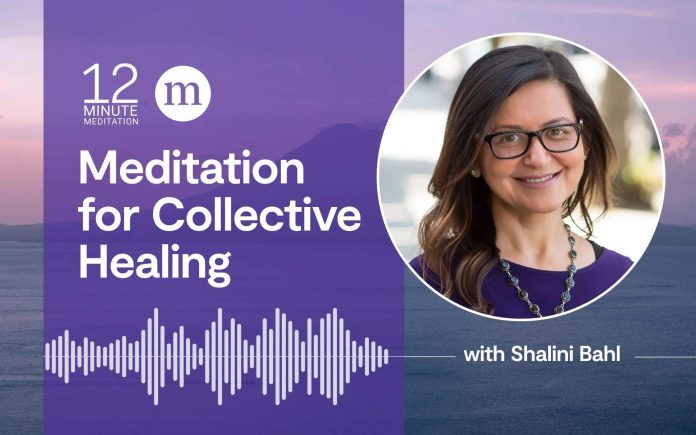In this guided practice, we cultivate collective healing amidst the ways we are all shaped by our experiences, fears, and hopes.
Key Points:
- The mindful practice of deeper understanding can help us when we seek to find common ground with people who seem different from ourselves.
- This meditation helps us to see that we are all shaped by our experiences, fears, and hopes, despite our differences.
- By reflecting on our experiences and shared humanity, we can better understand others and take meaningful action for collective healing.
In today’s interconnected yet paradoxically divided world, the path to understanding each other requires more than just good intentions. To truly connect and heal, we need something more: the cultivation of a deeper understanding. The path forward isn’t about eliminating differences—it’s about building bridges of understanding across them.
In this gentle yet powerful meditation with Shalini Bahl, we experience how we are all shaped by our experiences, fears, and hopes. Deep understanding is like diving below the illuminated surface to deeper waters. By understanding both what floats on the surface and what lies in the depths, we can begin to shift our habitual patterns and make choices that arise from genuine wisdom rather than reactive impulses.
A Meditation for Collective Healing
- In today’s practice, we’ll move through three steps. One, returning to a non-judging awareness; two, listening for deeper understanding; and three, beginning to take mindful action.
- Let’s start by taking a few minutes to simply pause and return to our non-judging awareness. Come to a comfortable sitting position, feeling the elongation along the back of the spine. Gently lift your shoulders up, back, and down, so that the breath can move at ease. Feel the support under your feet.
- You may lower or close your eyes. Bring your attention to your breath. Notice how it moves in and out of your body effortlessly. If it’s deep, let it be deep. If it’s shallow, let it be shallow. Simply invite your mind to be here with your breath and your body. If you like, let your attention rest in the region of your heart, feeling the spaciousness in your chest with each in-breath, and a gentle release with each outbreath.
- Gently bring to mind the situation causing tension or conflict. See it clearly as if watching from a slight distance. Notice what arises in your body. Perhaps there’s tightness in your chest or belly, or your breath becomes shallow. Notice with kindness that all the sensations are rising and dissolving in your body, and make room for all your sensations, all the emotions. Whether it’s grief or anger, frustration, sadness—notice with kindness, without trying to fix or suppress anything.
- Now, notice what thoughts are underlying these emotions. See the people involved, their expressions or words or tone of voice. Feel this spaciousness in your mind, like a vast sky where all the thoughts arising are passing by like clouds.
- Once you feel a little more space in your mind and your body, you can move to the next step: listening deeply. Set an intention to understand not just our experience and needs, but also extending that same understanding toward others involved.
- If you need some support getting into this posture of deep listening, here are some questions you can explore. If you need a little more time, you can always pause the recording or try some journaling. Begin with, What are your core needs in this situation? Perhaps you long for safety, acknowledgment, a healthy environment, respect for your values.
- Next, connect with our shared humanity with others. Silently reflect, Just like me, this person wants to be happy and healthy. Just like me, this person also cares for their family. Continue on your own with your shared similarities with this person or people. Just like me….
- From this place of connection, seek to understand what lived experiences might be shaping their current stance or actions. What assumptions or beliefs are you bringing to this situation?
- Continue to breathe deeply to create more space in your mind and body. Breathe out any rigidity or tension you may be holding. What else might be possible here? No need to search or strive for answers, just trusting our intention for a deeper understanding and seeing our shared humanity, knowing we will be guided to clarity with this inner compass.
- Feel free to pause this recording to go for a mindful walk in nature or do some journaling to create room for a deeper understanding. As clarity emerges, you may notice a release of tension. It might be a very subtle shift in our body or your breath becoming deeper or easier.
- From this place of connection with your intention and insights, you can move to the last step: considering possibilities for intentional, mindful action. These are small steps you can take to create more understanding and harmony in this situation. Let this intentional approach extend beyond this specific situation. For example, how might your choices around consumption—what you put into your body, how you source things—all support a mind and body guided by your intention and values?
- Remember, you can return to this practice whenever you need, using these three steps: return to your non-judging awareness, listen for deeper understanding, and begin to take aligned actions. Let’s take a final breath together. As we exhale slowly, may this practice benefit us and benefit all beings.


